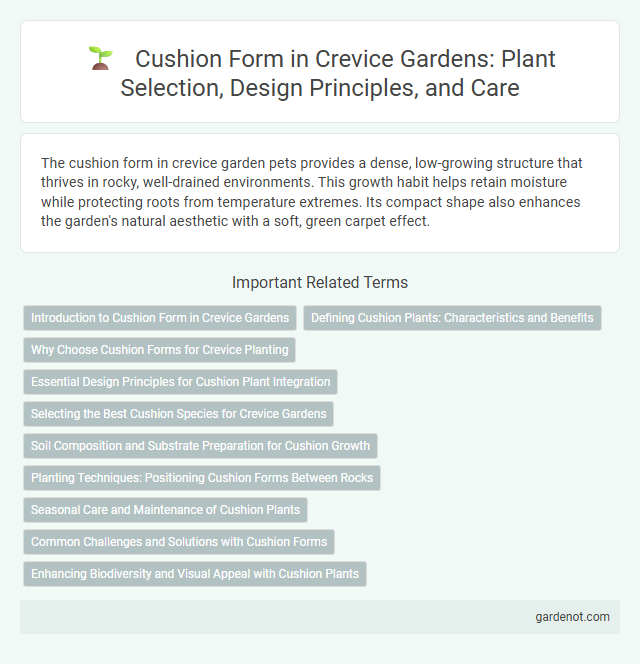The cushion form in crevice garden pets provides a dense, low-growing structure that thrives in rocky, well-drained environments. This growth habit helps retain moisture while protecting roots from temperature extremes. Its compact shape also enhances the garden's natural aesthetic with a soft, green carpet effect.
Introduction to Cushion Form in Crevice Gardens
Cushion form in crevice gardens refers to low-growing, compact plants that create dense, cushion-like mats, ideal for filling narrow gaps between rocks. These plants, such as saxifrages and sedums, thrive in the well-drained, mineral-rich environment of crevice gardens, enhancing both texture and structure. Cushion form species stabilize soil, reduce erosion, and provide visual interest through vibrant foliage and clusters of flowers.
Defining Cushion Plants: Characteristics and Benefits
Cushion plants are low-growing, dense mats of vegetation that thrive in harsh environments, particularly alpine and arid regions. Their compact cushion form minimizes water loss and protects against extreme temperatures, making them ideal for crevice gardens where space and resources are limited. These plants enhance soil stability and provide microhabitats that support biodiversity within crevice garden ecosystems.
Why Choose Cushion Forms for Crevice Planting
Cushion forms create dense, compact structures that maximize root anchorage and moisture retention in crevice gardens. Their low growth habit protects delicate plants from wind exposure and temperature fluctuations commonly found in rocky environments. This growth pattern enhances nutrient absorption and promotes healthier, more resilient crevice plants.
Essential Design Principles for Cushion Plant Integration
Cushion plants thrive in crevice gardens by maximizing soil retention and moisture conservation within tight rock fissures, supporting their compact, dome-shaped growth. Essential design principles for integrating cushion plants include selecting crevices with adequate drainage and sun exposure to mimic their natural alpine habitat. Proper spacing and substrate composition ensure healthy root expansion and airflow, promoting resilience and longevity in harsh environments.
Selecting the Best Cushion Species for Crevice Gardens
Selecting the best cushion species for crevice gardens involves prioritizing drought-tolerant, low-growing plants such as Silene acaulis, Arenaria montana, and Thymus serpyllum, which thrive in rocky, well-drained environments. These cushion plants enhance soil retention and provide essential microhabitats by mimicking natural alpine conditions, improving overall garden resilience. Optimal choices feature dense root systems and compact growth forms that maximize moisture conservation and withstand extreme temperature fluctuations.
Soil Composition and Substrate Preparation for Cushion Growth
Cushion plants thrive in well-drained, gritty soil composed of a mix of coarse sand, gravel, and organic matter to mimic their natural alpine habitat. Substrate preparation involves ensuring excellent drainage by incorporating materials like perlite or pumice and maintaining a slightly alkaline pH to prevent root rot. Proper soil composition and preparation facilitate root aeration and moisture regulation critical for robust cushion growth and longevity in crevice gardens.
Planting Techniques: Positioning Cushion Forms Between Rocks
Positioning cushion forms between rocks in crevice gardens enhances microclimate benefits, promoting moisture retention and root protection. Optimizing spacing ensures each plant receives adequate sunlight while minimizing competition, vital for species like silvery-leaved, drought-tolerant alpine herbs. Strategic planting techniques improve soil stabilization and mimic natural rock crevice habitats, fostering healthier, more resilient cushion plant growth.
Seasonal Care and Maintenance of Cushion Plants
Cushion plants in crevice gardens require seasonal care that includes regular watering during dry periods to maintain their compact, cushion-like form and prevent desiccation. Pruning after flowering promotes healthy growth and prevents the plants from becoming leggy, ensuring the dense, rounded shape characteristic of cushion plants. Applying a balanced, slow-release fertilizer in early spring supports robust growth throughout the growing season.
Common Challenges and Solutions with Cushion Forms
Cushion forms in crevice gardens often face challenges such as water retention issues and root rot due to compact soil in narrow crevices. Solutions include using well-draining soil mixes and incorporating granular grit to improve aeration while maintaining moisture balance. Selecting drought-tolerant cushion plants like Saxifraga or Silene also mitigates stress from fluctuating moisture levels.
Enhancing Biodiversity and Visual Appeal with Cushion Plants
Cushion plants in crevice gardens create dense, low-growing mats that enhance biodiversity by providing microhabitats for insects and small wildlife. Their compact growth habit retains moisture and reduces soil erosion in rocky crevices, supporting diverse plant communities. Vibrant cushion forms add visual appeal through varied textures and colors, enriching the garden's aesthetic and ecological value.
Cushion form Infographic

 gardenot.com
gardenot.com